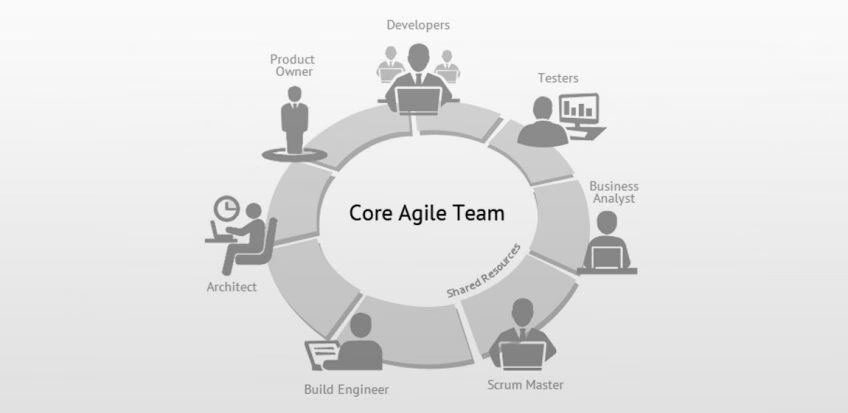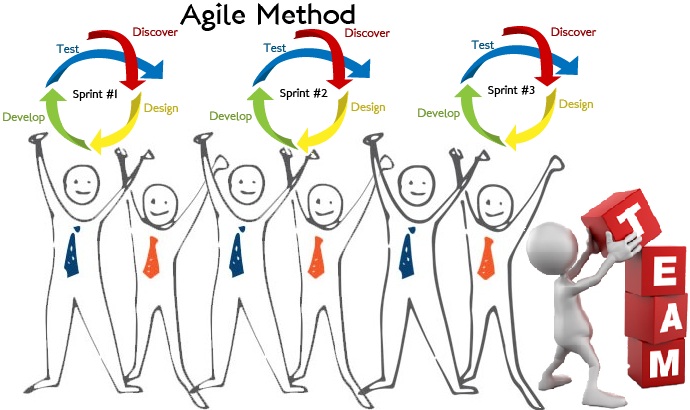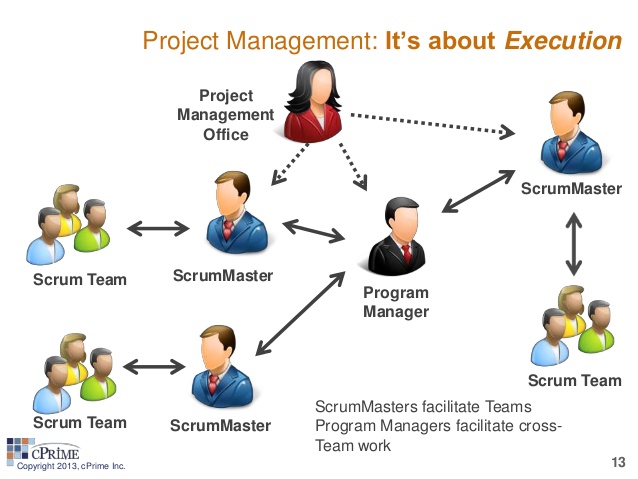
How to Build an Agile Development Team?
Interested in building an Agile development team?
Agile teams build great software applications. It is important you make your team Agile.
Creating great software applications is your company's ticket to the high life. A well-managed software development process is the only way to ensure your product is great.
Agile Development Team

The main component of any agile process is the development team. The ScrumMaster’s role is crucial in ensuring that the development team sticks to agile dictates and principles during each stage of the development process.
A ScrumMaster’s role is reduced as the agile development team becomes more and more efficient and effective in completing their daily tasks. A well-trained development team is vital as it is the prime responsibility of the development team to turn the product owner's vision into a tangible outcome.
In scrum projects, the development team consists of individuals who are stakeholders and responsible for delivering the product on time and on budget.
A scrum team is a cross-functional collaboration of skill sets, which includes front-end and back-end developers, designers, and testers.

Get a complimentary discovery call and a free ballpark estimate for your project
Trusted by 100x of startups and companies like
Are You Ready to Build an Agile Development Team?
Is there a winning recipe for a perfect agile development team? Although agile teams share common values, principles, and methodologies, there is no common formula for all developers, and their circumstances are different.
While some agile practitioners prefer co-located teams, there are instances where a single agile team is spread across the entire globe.
Similarly, there are also differences in the methodologies they adopt. Some agile team members prefer Scrum, while others might prefer Kanban.
I have already written about “How to Build a Scrum Development Team?”, and you can refer to that if you are specifically interested in the Scrum approach.
A solid team with the right mindset, training, management, etc. is the core foundation of agile development.
“Once the team is in place, it's important to remember that agile teams are like flowers: they take time to grow. Agile theorists often quote Tuckman's "stages of group development.”
To summarize, there are four crucial stages of development for agile teams:
- Forming: Chaos is a big factor in this phase and so teams need lots of mentoring and guidance from managers to clearly define job roles and responsibilities etc.
- Storming: There is a better understanding in this phase about team roles/communication channels etc, but regardless, it is still a very fragile stage. Team members still don't have enough trust in each other and methodologies still need to be taught so that they become second nature to each member of the team.
- Normalizing: This, in my opinion, is the most important phase. By now, relationships have stabilized and team members understand more about their roles within the team. Agile development team responsibilities, team goals, and objectives all become sacrosanct as the team begins to work in an optimized way.
- Performing: There is no ambiguity remaining at this stage in regard to the agile development team's roles and responsibilities. By now, all agile development teams are well versed in their individual roles and that of the team, so are performing well with minimal supervision.
Psychologist Bruce Tuckman had come up with this agile model.
The Roles in the Agile Methodology

As I mentioned earlier, an agile software development process starts with the following:
- Understanding and defining users
- Crafting and documenting a vision statement
- Defining the correct scope, opportunities, and outcome
User: Starts the process by clearly identifying the target audience. Correctly defines user personas and uses these to build different criteria/requirements in a workflow that the software aims to support.
Product owner: The product owner acts as a liaison between the customer and internal stakeholders, assuming there are some. I look at the product owner as an SME, who has deep knowledge and expertise in the problem that the software aims to solve.
He collaborates with the stakeholders and brings together innovative ideas, a set of desired goals, and feedback to put forth the product vision. Once the vision is defined, the product owner works with the development team to bring it to life.
Software development team: In agile, the development team and its members’ responsibilities differ from those in traditional software development.
Teams are multidisciplinary, composed of a diverse group of people with the required skills to get the job done. Because the focus is on delivering a fully operational piece of software, the team has to complete end-to-end development of the application and ensure it is tried and tested before launch.
In addition to developers, software development teams include quality assurance (QA) engineers, other engineers (such as for databases and back-end systems), designers, and analysts, depending on the type of software project.
Many large organizations are embracing agile to ensure project flexibility and shorter lead times. Ericsson is a classic example of a large organization introducing agile into a new research and development product development program.
Various Frameworks to Use in Your Agile Development Team
Some popular agile frameworks include the following:
Scrum
The most popular and widely used agile framework is Scrum. Scrum has been used to manage work on complex products since the early 1990s. Scrum is focused on breaking large projects into smaller stages, reviewing and adapting along the way.
Scrum incorporates a delivery cadence called a sprint. Sprints span from one week to one month in length and are continuing to keep projects moving at the fastest possible pace. There are three crucial events that happen within each sprint.
- Planning to identify sprint priorities.
- Daily Scrum Calls/Meetings – The development team meets for approximately 15 minutes every day to keep a tab on the team’s progress towards sprint goals and also identify blockers if any.
- Sprint Review – The agile development team collaborates and exchanges ideas/views about tasks completed and adapts the backlogs as required
- Sprint Retrospective – This is a great learning experience for the development team. The team openly discusses key items that went well, as well as instances where the team failed to meet expectations to improve things for the future.
Mayden is a small U.K. company that develops managed web applications for the healthcare sector. Are you interested in knowing how Scrum helped Mayden reduce lead time and improve employee productivity?
1,200 top developers
us since 2016
Read "Case Study: Mayden's Transformation from Waterfall to Scrum" to learn more about the challenges, approach, solution, and benefits.
Kanban
Kanban is a popular framework used to implement agile software development. It focuses on real-time communication and full transparency in regard to the work being undertaken.
Visualization lies at the heart of the Kanban framework. Work items are represented visually on a Kanban board. This helps the agile development team to see what stage the task is at any given point. Visualization makes it easy to identify the blockers and ways to eradicate them.
“Kanban is enormously prominent among today's agile software teams, but the kanban methodology of work dates back more than fifty years.
In the late 1940s, Toyota began optimizing its engineering processes based on the same model that supermarkets were using to stock their shelves.
Supermarkets stock just enough product to meet consumer demand, a practice that optimizes the flow between the supermarket and the consumer.”
Some of the benefits of adopting kanban include:
- Flexibility
- Shorter lead time
- Fewer bottlenecks
- Visualization of metrics
- Continuous delivery
Kanban Boards are excellent tools for daily stand-up meetings with the Agile development team. The Kanban Board has five grids:
- Backlog
- To-do
- In progress
- Review
- Done
Development management teams push Kanban cards from one grid to the other as and when the task gets completed. This visualization helps to quickly identify roadblocks and sets the right approach for tasks.
As teams get together during daily stand-ups, there is a free flow of information and better engagement, etc.
Extreme Programming (XP)
XP, originally described by Kent Beck, has emerged as one of the most popular and controversial agile methodologies. XP focuses on producing higher-quality software, and a better work environment for the agile development team.
XP is the most well-defined approach of the agile frameworks in project management in regard to appropriate engineering practices for software development.
Which is the right environment for using XP?
- Continuously changing software requirements
- Risks associated with fixed-time projects using new technology
- The agile development team size is small, and the team is colocated
- The technology used allows for automated unit and functional tests
The five core values of XP include:
- Communication
- Simplicity
- Feedback
- Courage
- Respect
Like other agile methods of development, "extreme programming" focuses on high customer involvement, a fast and consistent feedback mechanism, continuous planning and testing, effective collaboration, and teamwork to deliver working software at very frequent intervals.
XP allows agile development team members and customers to monitor and take necessary action about the project’s progress throughout the entire software development life cycle.
The core of XP is the interconnected set of software development practices listed below. While it is possible to do these practices in isolation, many teams have found that some practices reinforce others and consequently should be done in conjunction to fully eliminate the risks that developers often face during software development.
The original twelve practices of XP are as follows:
- The Planning Game
- Small Releases
- Metaphor
- Simple Design
- Testing
- Refactoring
- Pair Programming
- Collective Ownership
- Continuous Integration
- 40-hour week
- On-site Customer
- Coding Standard
Attributes of Successful Agile Development Teams

Are agile tools and methodologies enough to build a successful agile development team? An agile team without proper direction and guidance will fall fail.
So, it is the responsibility of each development team member, as well as the team manager, to nurture a healthy mindset and approach. A positive mindset when guided by an agile framework will create world-class products.
A few attributes of a successful agile development team include:
Collaboration
In a successful agile software development team, team members work together on product features. Developers and testers collaborate effectively to identify, start, define, and roll out features.
Collaboration prevents the risk of product features not getting rolled out at the end of each iteration and also ensures that they are built as well as they can be.
Open Communication and Feedback
A well-laid-out feedback mechanism is the basis of a successful agile team. Agile development team members utilize sprints as a way of building and reviewing the work they have done in stages.
Built-in increments help customers provide feedback on work finished during any given time. This feedback loop helps the team to learn from its mistakes and continually improve its output.
Adaptability
Any agile development team member needs to be extremely flexible to rapidly adapt to changing environments.
A set of adverse conditions may arise, such as a bug in the program, but the team needs to be mature enough to work their way around all problems and retain their focus on task completion. This is the sign of a good agile development team.
Engage Completely
The agile team should always maintain a culture of open knowledge-sharing and cooperation. The team should respect each other’s opinions and criticisms and have an open mindset to welcome new ideas.
Trust
Transparency and collaboration are at the heart of an agile software development team. Trust is a key ingredient here. Each team member should be empowered and must constantly motivate each other.
Planning to Build an Agile Development Team
Agile management has certainly changed the face of software development. It takes a holistic approach and strives to integrate product developers and customers in the planning and implementation stages.
As a result, everyone feels engaged and empowered, and so, the results are vastly improved.
According to the Project Management Institute, “Agile approaches to project management aim for early, measurable ROI through defined, iterative delivery of product increments. They feature the continuous involvement of the customer throughout the product development cycle.
Although agile has its roots in software and IT, agile adoption is growing and expanding in a wide range of industries.”
If you, as a business CEO or CTO, are planning to build an agile development team for your software project, DevTeam.Space can help you with its vetted and field-expert software development team. All these software developers are well-versed in agile software development processes.
You can easily partner with them for your next agile development project by sending us your initial project specifications via this form.
One of our account managers will get back to you to discuss more on agile project sprint planning, execution, risk management, etc.
Frequently Asked Questions
This is a software development team that uses the Agile methodology to guide the development process. A complex project may well include a number of cross-functional teams working on many different aspects of app functionality at once.
Team leader, team members, and the product owner.
The best Agile development teams can be found at DevTeam.Space. It has its own Agile-driven software development methodology. All our high-quality developers are managed to help reduce the strain on the client-side project manager.


